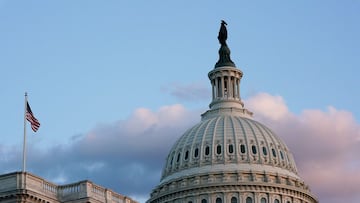How long has passed since the first three stimulus checks were sent and how has the US economy changed?
The three federal stimulus checks approved by Congress in March and December 2020 and March 2021 made significant impacts on the US economy.


In March 2020, as the covid-19 pandemic brought life and the economy to a halt, the federal government had no choice but to act.
Within weeks, unemployment skyrocketed as businesses shut their doors, not knowing when they would be able to reopen them. Children, millions of which receive free breakfast and lunch through school programs, were now stuck at home, leading to fears that many would go hungry.
Within weeks of major shutdowns, Congress passed the Coronavirus Aid, Relief, and Economic Security (CARES) Act, which sent direct assistance to millions of households. The payment of $1,200 stimulus checks and enhanced unemployment benefits that provided more generous and expanded coverage helped the country avert a total economic collapse.
The second and third stimulus checks, worth $600 and $1,400, respectively, also helped keep the economy afloat as new waves of the virus hindered the economic recovery.
🚨 STIMULUS CHECK FACTS 🚨
— Rep. Joyce Beatty (@RepBeatty) June 3, 2021
🍲 Helped reduce food insecurity by 40%.
💰 Helped reduce financial instability by 45%.
❤️🩹 Helped reduce reported adverse mental health symptoms by 20%.
0⃣ Republicans voted for last round of stimulus checks.#ByTheNumbers #HelpIsHere
CARES Act
The CARES Act was signed into law by President Trump on 27 March 2020.
Shortly, after the IRS quickly began distributing $1,200 stimulus checks. When the checks were sent, the unemployment rate in the United States stood at 14.8 percent. Additionally, in late April, 38 percent of respondents to the Household Pulse Survey (HPS) had reported that they believed they or someone in their household would lose income in the next four weeks.
In addition to sending direct payments, the federal government enacted an eviction moratorium that protected homeowners and tenants. In the HPS data taken between late April and early May, nearly 24 percent of tenants responsible for paying rent said they were “not confident” or only “slightly confident” that they would be able to make the payment on time.
This rate was highest in Louisiana (34.7%), Mississippi (34.1%), and New York (33.1%).
By early May, many households had received their stimulus check. However, rates of food insecurity did not drop quickly as a result. The HPS asks respondents if within the last seven days there was “either sometimes or often not enough to eat.” In the six weeks following the sending of the first check, around one in ten households reported that they were experiencing food insecurity.
- 23 April - 5 May: 9.8%
- 7 - 12 May: 10.6%
- 14 - 19 May: 10.8%
- 21 - 26 May: 9.9%
- 28 May - 2 June: 10.7%
- 4 - 9 June: 10.3% .
However, thanks to stimulus checks and more generous unemployment benefits, including a $600 federal topper sent in addition to state benefits from April to July, personal income actually increased in the second quarter of 2020. From January to March, total personal income stood at $18.2 billion and increased to $20.3 billion from April to June. Quickly, these numbers began to decrease as people spent their stimulus money and the $600 topper expired; from July to September, the Bureau of Economic Analysis recorded total personal income at $19.7 billion.
However, as the year ended, the numbers suggest that more households were beginning to show signs of economic distress. These economic indicators captured in the survey mirrored the worsening health situation the US faced in late 2020; with infection, hospitalization, and death rate on the rise, businesses closed, and finding work became increasingly difficult.
Second Stimulus Check
In December 2020, Congress passed the Coronavirus Response and Relief Supplemental Appropriations (CRRSA) Act of 2021, which included funding to send a $600 stimulus check.
President Trump had pushed lawmakers to boost the amount sent, but members of his own party opposed the measure, claiming it was financially irresponsible. To boost household incomes even further, Congress also decided to send a $300 topper in addition to state unemployment benefits.
By the time the second payment was made, households were struggling.
In early December 2020, food insecurity hit an all-time high. Almost 20 percent of adults with children reported that they “sometimes or often” did not have access to enough food.
Additionally, 35 percent reported having trouble covering basic expenses. With the size of the check being so much smaller than the first, it did not have the same impact on people’s spending habits. By the end of January, the 35 percent figure remained unchanged.
Before the check was sent, one in ten households reported having trouble making their rent or mortgage payments. Louisiana (17%) and Mississippi (13%) had the highest rates. After the direct payments were distributed, this rate fell to 8 percent.
While personal income rose dramatically in the first quarter of 2021 (January to March), this was primarily driven by sending the third and largest stimulus check.
Third Stimulus Check
The third federal direct payment worth $1,400 was included in the American Rescue Plan. The Rescue Plan also extended the $300 topper that was enacted through the CRRSA. The law also made many changes to the US tax code, including the Child Tax Credit, which made more taxpayers eligible for larger returns this year.
Get details about what drove the U.S. economy’s growth in the second quarter. Read our blog: https://t.co/HHLSpoKjJi. pic.twitter.com/sMDyKMM3Z2
— BEA News (@BEA_News) August 26, 2021
All of these factors contributed to a serious increase in overall household wellbeing.
Researchers at the University of Michigan found that through the passage of the CRRSA and the ARP, hardship, as reported by respondents, dropped sharply, particularly among “adults with children, and adults living in households with annual incomes less than $25,000.” The downward trend was seen by those with higher incomes as well.
For example, around Christmas in 2020, nearly one-third of families with the lowest incomes in the US reported lacking sufficient access to food. After injecting trillions of dollars in stimulus, these numbers fell to twenty percent in April.
Related stories

California stimulus check: how many more payments remain to be sent in 2021?

Third batch of California stimulus checks: how to check if I received it?
At a macroeconomic level, personal income and consumer spending increased dramatically. However, these levels have since tapered off as no further stimulus has been injected into the economy. Some economists had hoped that the sending of the Child Tax Credit payments would increase personal income. However, because the payments are smaller than stimulus checks, they have not led to the same sharp increases.
Where does this leave us?
Based on the current political landscape, the chances of a fourth stimulus check being passed are small. Democrats are focused on averting a debt ceiling crisis and the passage of the $3.5 trillion reconciliation bill.
Republicans have long blamed the checks on slow labor market reentry, saying that they give people an incentive to stay home. However, with federal unemployment benefits ending and slow job growth reported in August, more stimulus may be needed to keep the recovery moving. Whether or not that will come in the form of a stimulus check, is still very much up for debate.